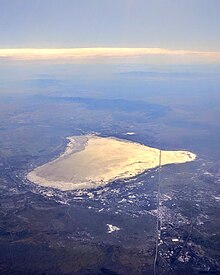Willcox Playa
It is part of the Sonoran Desert ecoregion and is the remnant of a Pleistocene era pluvial Lake Cochise.
[1][2] It was designated a National Natural Landmark in 1966 for its fossil pollen captured underground, the thousands of sandhill cranes that roost in the area and the largest diversity of tiger beetles in the United States.
During the summer, intense solar heating sometimes gives rise to large dust devils, and strong winds from thunderstorms and winter storms can produce dust storms rising from the dry lake that can hinder traffic on the Interstate 10 highway.
In the vicinity of the dry lake is the Willcox Playa Wildlife Area administered by the Arizona Game and Fish Department.
The location boasts rich wildlife, and hosts the annual January birding festival Wings Over Willcox.
